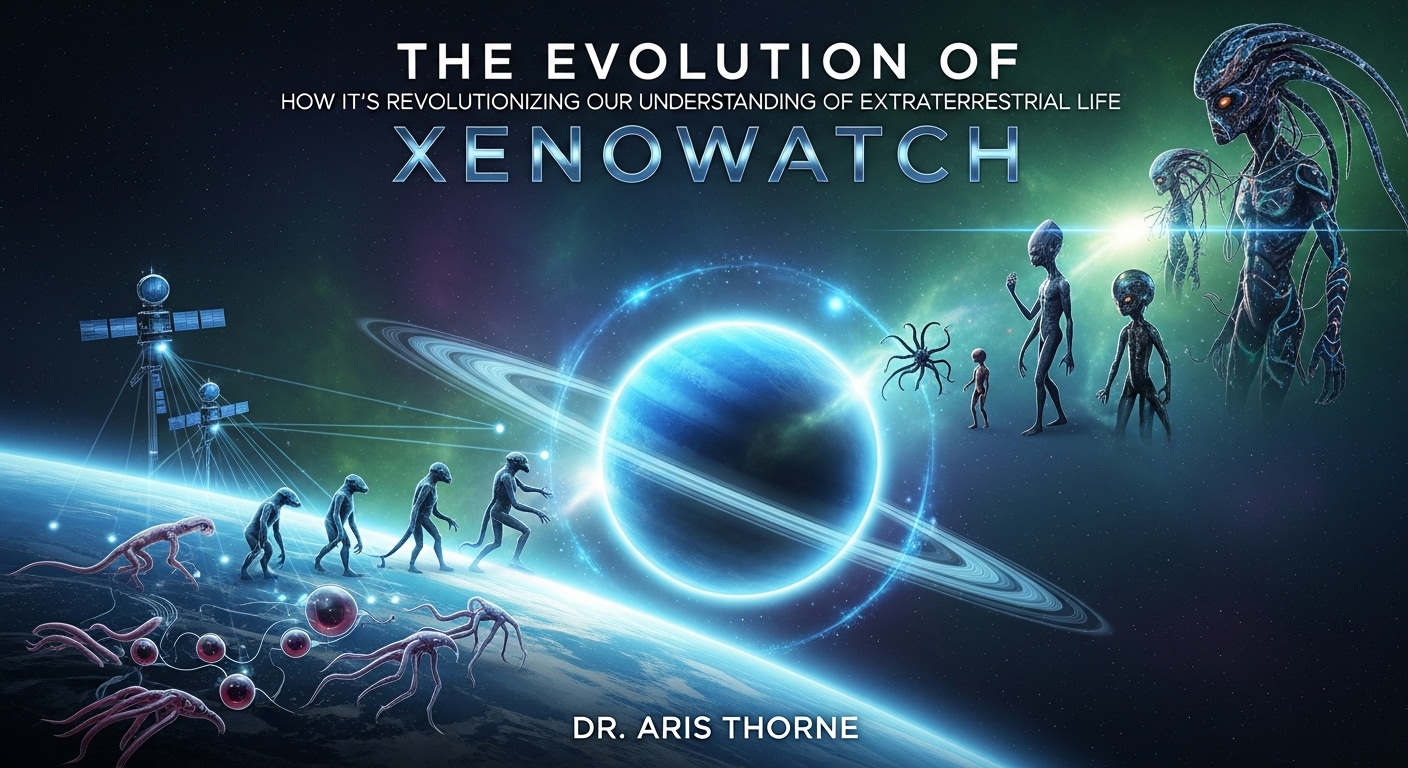
The Evolution of Xenowatch: How It’s Revolutionizing Our Understanding of Extraterrestrial Life

The search for extraterrestrial life has long captivated human imagination and scientific inquiry. Over the years, technological advances have continually pushed the boundaries of this exploration, leading to the development of groundbreaking tools and methodologies. One such pivotal advancement is Xenowatch, a platform that has revolutionized our approach to understanding and detecting extraterrestrial life. This blog post delves into the evolution of Xenowatch and its transformative impact on astrobiology and space exploration.
What is Xenowatch?
Xenowatch is an innovative platform that utilizes cutting-edge technology to monitor, analyze, and interpret signals from outer space. Its primary aim is to detect potential signs of life beyond Earth. By leveraging advanced algorithms and machine learning, Xenowatch processes vast amounts of data collected from various space observation instruments, including telescopes, satellites, and space probes.
The platform was developed in response to the growing need for more sophisticated tools to analyze the increasing volume of data from space. With the advent of next-generation telescopes and enhanced space missions, the capability to process and interpret data efficiently has become more critical than ever.
The Evolution of Xenowatch
Initially, Xenowatch was conceived as a simple monitoring tool designed to analyze radio signals from deep space. However, as technology advanced, so did the platform. Today, Xenowatch is an integrated system capable of handling data from multiple sources and in various formats, including optical, radio, and infrared signals.

The evolution of Xenowatch can be attributed to several key developments:
- Integration of AI and Machine Learning: The incorporation of artificial intelligence has significantly enhanced Xenowatch’s capabilities. Machine learning algorithms allow the platform to identify patterns and anomalies that may indicate the presence of extraterrestrial life. This has reduced the time required for data analysis and increased the accuracy of findings.
- Interdisciplinary Collaboration: Xenowatch’s evolution has been fueled by collaboration between astronomers, astrophysicists, computer scientists, and engineers. This interdisciplinary approach has facilitated the development of more sophisticated data processing techniques and improved the overall efficiency of the platform.
- Enhanced Data Collection: As space exploration missions have become more advanced, the quality and quantity of data collected have improved. Xenowatch has evolved to accommodate these changes, processing data from sources such as the James Webb Space Telescope and the Mars Rover 2020.
Xenowatch’s Impact on Astrobiology
Xenowatch has had a profound impact on astrobiology, the study of life in the universe. By providing a more comprehensive understanding of extraterrestrial environments, Xenowatch has opened new avenues for research and exploration.
One of the most significant contributions of Xenowatch to astrobiology is its ability to detect biosignatures. Biosignatures are chemical indicators that suggest the presence of life, such as methane or oxygen. Xenowatch’s advanced algorithms can identify these signatures in the data collected from distant planets and moons, allowing scientists to target their search for life more effectively.

Moreover, the platform’s capability to analyze data from diverse sources enables researchers to study a wide range of extraterrestrial environments. For instance, Xenowatch has been instrumental in analyzing data from Europa, one of Jupiter’s moons, where the presence of a subsurface ocean raises the possibility of microbial life.
Case Studies: Xenowatch in Action
The impact of Xenowatch can be illustrated through several notable case studies:
Detection of Exoplanets
Xenowatch has played a crucial role in the discovery and analysis of exoplanets, planets located outside our solar system. By processing data from space telescopes like the Kepler Space Telescope, Xenowatch has helped identify numerous exoplanets that may possess conditions conducive to life.
Investigation of Martian Atmosphere
Data from the Mars Rover missions, analyzed through Xenowatch, have provided valuable insights into the Martian atmosphere. Specifically, the detection of methane spikes on Mars has led scientists to consider the possibility of microbial life beneath the planet’s surface.
Analysis of Venusian Clouds
In a recent breakthrough, Xenowatch contributed to the analysis of data suggesting the presence of phosphine in the clouds of Venus. This discovery has sparked renewed interest in the planet as a potential habitat for life, prompting further exploration and study.
The Future of Xenowatch

Looking ahead, the future of Xenowatch is bright. Continuous advancements in technology are expected to further enhance the platform‘s capabilities, enabling more detailed and accurate analyses of extraterrestrial environments. Several key developments are anticipated:
- Expanded Data Sources: As space agencies launch new missions and deploy more advanced instruments, the volume and diversity of data available to Xenowatch will continue to grow. This will allow for more comprehensive studies of potential life-supporting environments.
- Improved AI Algorithms: Ongoing research in AI and machine learning will likely lead to even more sophisticated algorithms for data analysis, increasing the accuracy and speed of Xenowatch’s findings.
- Collaborative Endeavors: The success of Xenowatch has demonstrated the value of interdisciplinary collaboration. Future efforts will likely involve even greater cooperation across various scientific fields to enhance our understanding of extraterrestrial life.
Takeaways
Xenowatch has undoubtedly revolutionized our understanding of extraterrestrial life. By harnessing the power of advanced technology and interdisciplinary collaboration, it has transformed the way scientists study the cosmos. As we continue to explore the universe, Xenowatch will remain a critical tool in the quest to answer one of humanity’s most profound questions: Are we alone in the universe?
The evolution of Xenowatch is a testament to human ingenuity and the relentless pursuit of knowledge. With each new discovery, we move closer to unveiling the mysteries of the universe and understanding our place within it. As Xenowatch continues to evolve, it will undoubtedly play an integral role in shaping the future of space exploration and astrobiology.
Challenges and Considerations
While Xenowatch has achieved significant milestones, it is not without its challenges. The search for extraterrestrial life is fraught with complexities that require careful consideration and innovative solutions.
Data Overload

One of the primary challenges faced by Xenowatch is the sheer volume of data generated by modern space missions. With new telescopes and satellites constantly feeding data into the system, Xenowatch must continuously adapt to manage and process this influx effectively. Developing more efficient algorithms and storage solutions is critical to prevent data bottlenecks and ensure timely analysis.
Signal Interpretation
Interpreting signals from space is inherently complex. Differentiating between genuine biosignatures and false positives requires a high degree of precision. For instance, non-biological processes can sometimes produce gases like methane, leading to ambiguous results. Xenowatch must constantly refine its methodologies to improve the accuracy of signal interpretation and reduce the likelihood of false detections.
Technological Limitations
Despite significant technological advancements, certain limitations persist. The resolution and sensitivity of current instruments, while impressive, are still not sufficient to provide definitive proof of life on other planets. Ongoing research and development efforts are essential to overcome these limitations and enhance the capabilities of Xenowatch.
Collaborative Efforts and Global Partnerships
To maximize the potential of Xenowatch, collaboration with international space agencies and research institutions is vital. Sharing data and resources allows for a more comprehensive approach to studying extraterrestrial life.
Organizations like NASA, the European Space Agency (ESA), and other global partners have been instrumental in providing valuable data and expertise. These partnerships foster a collaborative environment that accelerates scientific progress and facilitates the exchange of innovative ideas.
Ethical Implications and Public Engagement

As the search for extraterrestrial life progresses, ethical considerations and public engagement become increasingly important. The potential discovery of extraterrestrial life raises profound philosophical and ethical questions that require careful reflection.
Implications for Humanity
The confirmation of extraterrestrial life would have far-reaching implications for our understanding of life and our place in the universe. It would challenge existing paradigms and prompt a reevaluation of our responsibilities as stewards of Earth.
Public Involvement
Engaging the public in discussions about the search for extraterrestrial life is crucial. Initiatives such as citizen science projects and educational outreach programs can foster a deeper appreciation for the scientific process and inspire future generations of researchers. Transparency and open communication are key to maintaining public trust and interest in Xenowatch’s endeavors.
The Broader Impact of Xenowatch
Beyond its primary mission of detecting extraterrestrial life, Xenowatch has broader implications for science and technology. The advancements in data processing, AI, and machine learning driven by Xenowatch have applications across various fields, from climate modeling to healthcare.
Moreover, the collaborative model established by Xenowatch serves as a blueprint for future scientific endeavors. By uniting experts from diverse disciplines, Xenowatch demonstrates the power of collective problem-solving in addressing complex challenges.
Takeaways
The evolution of Xenowatch marks a significant milestone in our quest to understand the universe and our place within it. As we continue to push the boundaries of scientific exploration, Xenowatch stands at the forefront, guiding us toward new discoveries and insights.
With each advancement, Xenowatch brings us closer to answering one of humanity’s most profound questions: Are we alone in the cosmos? As we look to the future, the potential for groundbreaking discoveries remains vast, promising to reshape our understanding of life beyond Earth and inspire generations to come.



